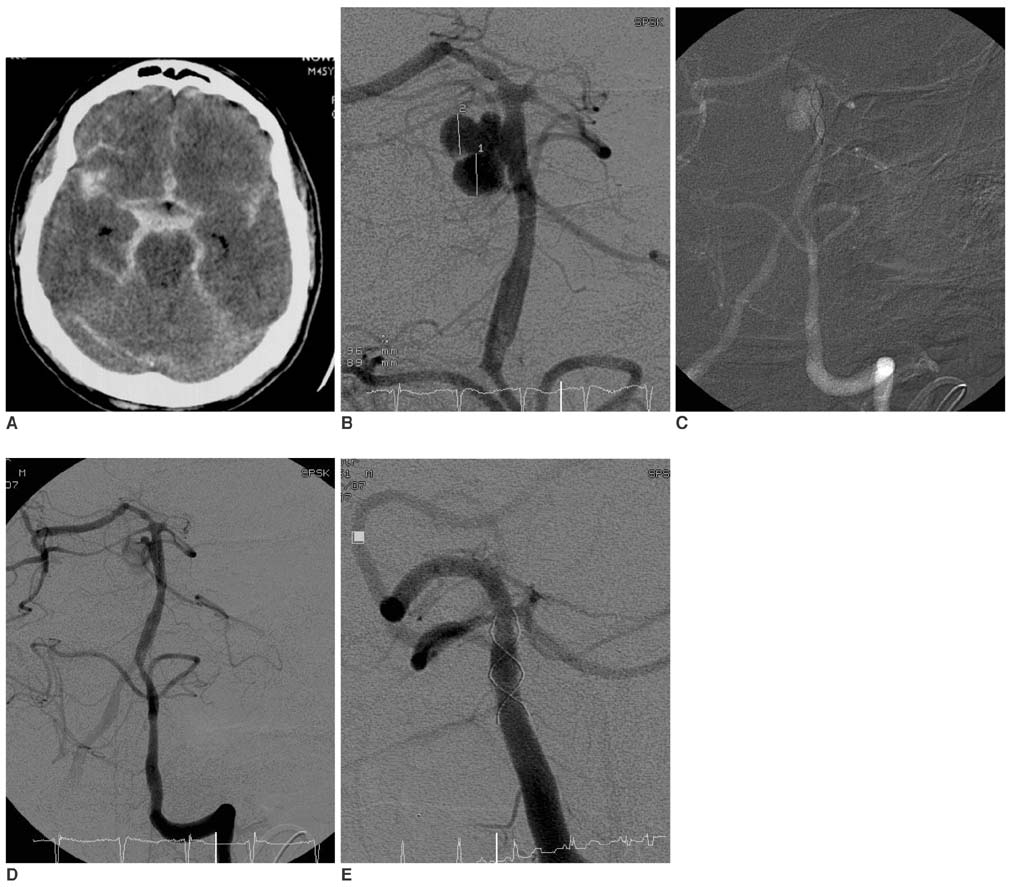Korean J Radiol.
2008 Aug;9(4):371-374. 10.3348/kjr.2008.9.4.371.
Complete Obliteration of a Basilar Artery Aneurysm after Insertion of a Self-Expandable Leo Stent into the Basilar Artery without Coil Embolization
- Affiliations
-
- 1Department of Neurosurgery and Neurotraumatology, Poznan University of Medical Sciences, Poznan, Poland. radiologiamim@wp.pl
- 2Department of Neuroradiology, Poznan University of Medical Sciences, Poznan, Poland.
- KMID: 1076464
- DOI: http://doi.org/10.3348/kjr.2008.9.4.371
Abstract
- We report a case of a 45-year-old man who underwent endovascular treatment in the acute setting of a subarachnoid hemorrhage due to rupture of a wide-necked basilar trunk aneurysm. The patient was treated with stent implantation without coiling. A control angiographic scan obtained immediately after the procedure revealed significantly decreased intraaneurysmal flow. Follow-up angiography performed after one month demonstrated total aneurysm occlusion.
MeSH Terms
Figure
Reference
-
1. Guglielmi G, Vinuela F, Dion J, Duckwiler G. Electrothrombosis of saccular aneurysms via endovascular approach. Part 2: Preliminary clinical experience. J Neurosurg. 1991. 75:8–14.2. Kis B, Weber W, Berlit P, Kuhne D. Elective treatment of saccular and broad-necked intracranial aneurysms using a closed-cell nitinol stent (Leo). Neurosurgery. 2006. 58:443–450.3. Szikora I, Berentei Z, Kulcsar Z, Barath K, Berez A, Bose A, et al. Endovascular treatment of intracranial aneurysms with parent vessel reconstruction using balloon and self expandable stents. Acta Neurochir (Wien). 2006. 148:711–723.4. Fiorella D, Albuquerque FC, Han P, McDougall CG. Preliminary experience using the Neuroform stent for treatment of cerebral aneurysms. Neurosurgery. 2004. 54:6–16.5. Lieber BB, Gounis MJ. The physics of endoluminal stenting in the treatment of cerebrovascular aneurysms. Neurol Res. 2002. 24:S33–S42.6. Soeda A, Sakai N, Sakai H, Iihara K, Nagata I. Endovascular treatment of asymptomatic cerebral aneurysms: anatomic and technical factors related to ischemic events and coil stabilization. Neurol Med Chir (Tokyo). 2004. 44:456–465.7. Vanninen R, Manninen H, Ronkainen A. Broad-based intracranial aneurysms: thrombosis induced by stent placement. AJNR Am J Neuroradiol. 2003. 24:263–266.8. Lopes D, Sani S. Histological postmortem study of an internal carotid artery aneurysm treated with the Neuroform stent. Neurosurgery. 2005. 56:E416.9. Benndorf G, Herbon U, Sollmann WP, Campi A. Treatment of a ruptured dissecting vertebral artery aneurysm with double stent placement: case report. AJNR Am J Neuroradiol. 2001. 22:1844–1848.10. Yu SC, Zhao JB. A steady flow analysis on the stented and non-stented sidewall aneurysm models. Med Eng Phys. 1999. 21:133–141.
- Full Text Links
- Actions
-
Cited
- CITED
-
- Close
- Share
- Similar articles
-
- Stent Assisted Coil Embolization of Unruptured Aneurysm Associated with Basilar Artery Fenestration: A Case Report
- Rupture Basilar Artery Dissection: Successful Treatment with Neuroform Stent Placement and Coil Embolization
- Kissing Aneurysms at Fenestrated Proximal Basilar Artery: Double-barrel Stent-assisted Coiling Using Dual Closed-cell Stents
- Dual Stent-Assisted Coil Embolization for Fusiform Aneurysm Arising From Persistent Trigeminal Artery
- Staged Y-shaped Stent Assisted Coil Embolization in a Wide-Neck Basilar Tip Aneurysm: Case Report


